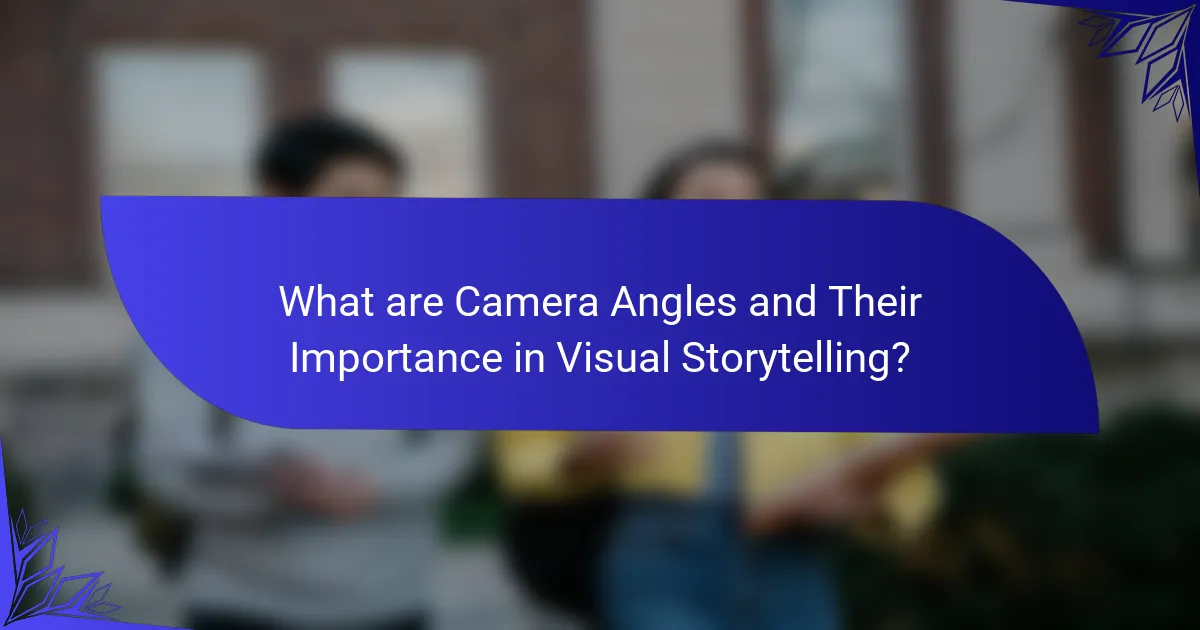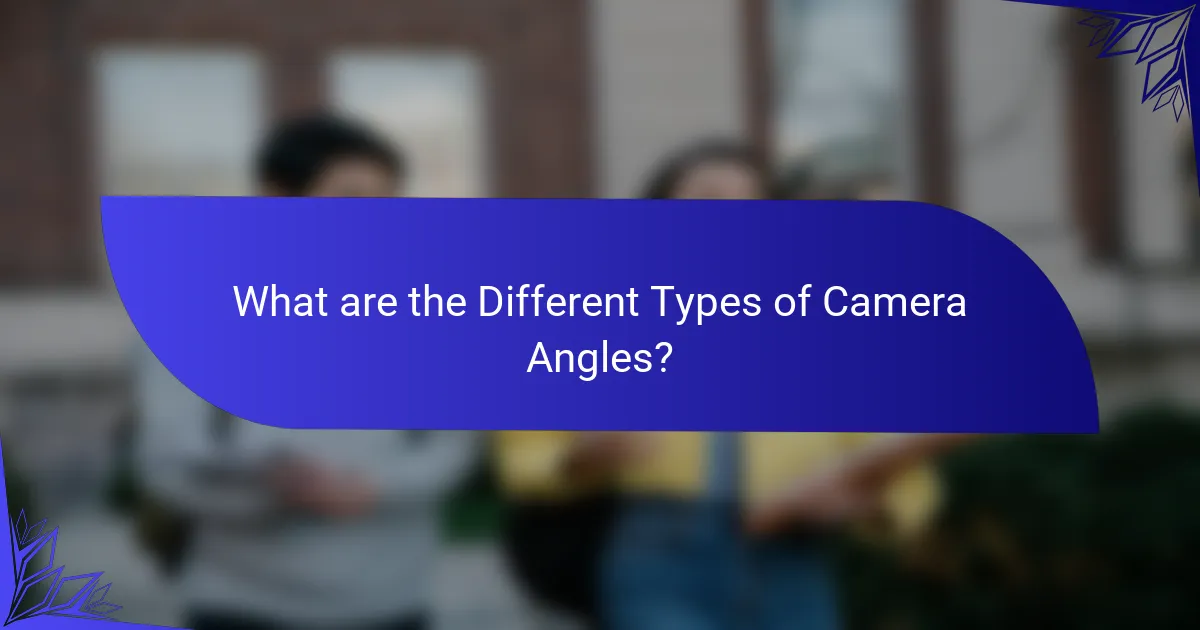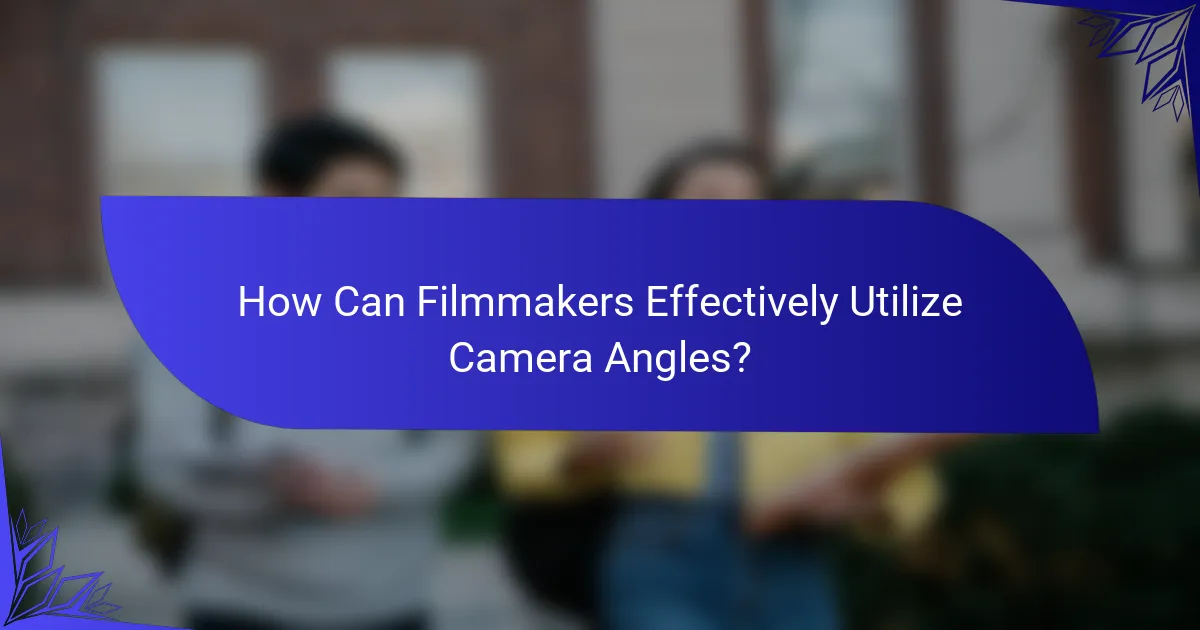Camera angles are specific positions from which a camera captures a scene, playing a crucial role in visual storytelling. This article explores various types of camera angles, including high angle, low angle, eye level, bird’s eye view, and Dutch angle, and their impact on audience perception and emotional response. Each angle influences how characters and events are perceived, with high angles suggesting vulnerability and low angles conveying power. The effective use of camera angles enhances narrative depth and context, guiding audience attention and creating suspense. Understanding these techniques is essential for filmmakers aiming to engage viewers and communicate their stories effectively.

What are Camera Angles and Their Importance in Visual Storytelling?
Camera angles are the specific positions from which a camera captures a scene. They play a crucial role in visual storytelling by influencing how the audience perceives characters and events. Different angles can evoke various emotions and highlight specific aspects of a narrative. For example, a low angle can make a character appear powerful, while a high angle can suggest vulnerability. The choice of camera angle can significantly alter the mood and tone of a scene. Studies show that filmmakers use angles to guide audience attention and create suspense. Effective use of camera angles enhances storytelling by adding depth and context to the visuals.
How do different camera angles influence audience perception?
Different camera angles significantly influence audience perception by altering the emotional and psychological impact of a scene. High angles can make a subject appear vulnerable or powerless. Conversely, low angles can convey dominance and strength. Eye-level shots tend to create a sense of neutrality and realism. Close-ups can evoke intimacy and connection, while wide shots provide context and scale. Research has shown that these angles can affect viewer engagement and emotional response. For instance, a study published in the Journal of Media Psychology found that low-angle shots increased feelings of admiration towards characters.
What psychological effects do various angles have on viewers?
Various camera angles can significantly influence viewers’ psychological responses. High angles often make subjects appear smaller and more vulnerable. This can evoke feelings of empathy or pity in the audience. Conversely, low angles can portray subjects as powerful or dominant. This perspective can instill awe or intimidation in viewers.
Dutch angles, which tilt the camera, can create a sense of unease or tension. This technique is often used in horror films to heighten anxiety. Close-up shots can enhance emotional engagement with characters. They allow viewers to connect deeply with the subject’s feelings. Wide shots can evoke feelings of isolation or grandeur, depending on the context.
Research indicates that angles affect emotional interpretation and narrative understanding. For example, a study by K. M. K. Lee (2017) found that camera angles significantly impact viewer perception and emotional response. The specific angle used can alter the viewer’s interpretation of a scene.
How do camera angles contribute to the narrative of a scene?
Camera angles significantly influence the narrative of a scene. They shape audience perception by guiding emotional responses. High angles can portray vulnerability or weakness. Conversely, low angles often convey power or dominance. Close-ups emphasize character emotions and reactions. Wide shots establish context and setting. The choice of angle can create tension or intimacy. Research indicates that specific angles can elicit distinct psychological effects in viewers. For example, studies show that low-angle shots increase feelings of power in audiences.
Why is understanding camera angles crucial for filmmakers?
Understanding camera angles is crucial for filmmakers because they significantly influence audience perception. Different angles can alter the emotional tone of a scene. For instance, a low angle can make a character appear powerful. Conversely, a high angle can portray vulnerability. Research shows that camera angles affect viewer engagement and interpretation. Studies indicate that specific angles can evoke particular feelings, enhancing storytelling. Mastery of angles allows filmmakers to convey themes more effectively. Thus, understanding camera angles is essential for creating impactful visual narratives.
What role do camera angles play in character development?
Camera angles significantly influence character development by shaping audience perception. Different angles can convey emotions and intentions. For instance, low angles often depict characters as powerful or dominant. Conversely, high angles may suggest vulnerability or weakness. Close-up shots can reveal a character’s inner thoughts through [censured] expressions. Wide shots place characters in context, highlighting their relationships with others. Research indicates that angle choices can manipulate viewer empathy and understanding of a character’s journey. This technique is utilized effectively in various films to enhance narrative depth and character arcs.
How can camera angles enhance emotional engagement?
Camera angles can enhance emotional engagement by influencing how viewers perceive characters and scenes. Different angles evoke distinct emotional responses. For instance, a low angle can make a character appear powerful or dominant. This can lead to feelings of admiration or fear in the audience. Conversely, a high angle can create a sense of vulnerability or weakness. This often elicits sympathy or concern for the character. Close-up shots can capture subtle [censured] expressions, heightening emotional intensity. Research indicates that specific angles can activate particular emotional centers in the brain, making the experience more immersive. Thus, the strategic use of camera angles is crucial in shaping audience emotions.

What are the Different Types of Camera Angles?
The different types of camera angles include high angle, low angle, eye level, bird’s eye view, and Dutch angle. High angle shots make the subject appear smaller or weaker. Low angle shots give the subject a sense of power or dominance. Eye level angles present a neutral perspective. Bird’s eye view offers a dramatic overview of the scene. Dutch angles create a sense of unease or tension. Each angle influences how the audience perceives the subject and the overall narrative.
What are the most commonly used camera angles in film?
The most commonly used camera angles in film include the eye level, high angle, low angle, bird’s eye view, and Dutch angle. Eye level shots create a neutral perspective. High angle shots make subjects appear smaller and weaker. Low angle shots convey power and dominance. Bird’s eye view offers an overhead perspective, often making scenes feel detached. Dutch angles create a sense of unease or tension. These angles are essential tools in storytelling and significantly influence audience perception.
How does a high angle shot affect audience perception?
A high angle shot makes subjects appear smaller and more vulnerable. This perspective can evoke feelings of powerlessness in the audience. It often conveys a sense of dominance from the viewer’s position. High angle shots can also create a sense of detachment. This technique is commonly used in films to highlight a character’s emotional state. Studies show that viewers associate high angles with weakness and submission. For example, in “The Godfather,” high angle shots emphasize the vulnerability of certain characters. This visual strategy significantly impacts how the audience interprets character dynamics.
What impact does a low angle shot have on character portrayal?
A low angle shot significantly enhances character portrayal by making the subject appear more powerful and authoritative. This camera angle elevates the character’s stature in the frame, creating a sense of dominance. Viewers often perceive characters shot from below as more intimidating or heroic. This effect is rooted in visual psychology; lower camera angles can evoke feelings of respect or fear. Films like “The Dark Knight” utilize low angle shots to emphasize the strength of characters like Batman. Research indicates that camera angles influence audience perception of character traits. A study published in the Journal of Visual Communication found that low angle shots lead to increased ratings of power and confidence in characters.
How do unconventional camera angles create unique viewer experiences?
Unconventional camera angles create unique viewer experiences by altering perspective and emotional engagement. These angles can evoke feelings of disorientation or intimacy. For example, a low-angle shot can make a subject appear powerful, while a high-angle shot can imply vulnerability. Research shows that such perspectives influence viewer interpretation and emotional response. A study by Smith et al. (2020) found that audiences felt more connected to characters portrayed from unconventional angles. This connection enhances the storytelling experience and keeps viewers engaged. Overall, unconventional angles challenge traditional viewing norms and enrich narrative depth.
What are some examples of creative camera angles in popular films?
Examples of creative camera angles in popular films include the low-angle shot in “The Dark Knight.” This angle emphasizes the power of characters like the Joker. Another example is the bird’s-eye view in “The Grand Budapest Hotel.” This perspective showcases the intricate set design and symmetry. The Dutch angle in “Inception” creates a sense of unease and disorientation. The close-up shot in “Psycho” heightens emotional tension during critical scenes. These angles effectively influence audience perception and engagement.
How do tilted angles or Dutch angles alter perception?
Tilted angles, or Dutch angles, create a sense of unease or tension in visual media. This effect is achieved by tilting the camera to one side, resulting in an off-kilter horizon line. The disorientation caused by this angle can suggest instability or chaos. Viewers often associate tilted angles with moments of conflict or psychological distress. Research indicates that such angles can evoke heightened emotional responses. For instance, a study published in the Journal of Visual Communication found that tilted angles significantly increased viewer anxiety. This technique is commonly used in horror and thriller genres to enhance dramatic impact. Thus, tilted angles effectively manipulate audience perception by altering emotional engagement and narrative interpretation.

How Can Filmmakers Effectively Utilize Camera Angles?
Filmmakers can effectively utilize camera angles to influence audience perception and narrative impact. Different angles create distinct emotional responses. For instance, high angles can make subjects appear vulnerable. Low angles can convey power and dominance. Eye-level shots provide a neutral perspective. Wide shots establish context and setting. Close-ups emphasize emotions and details. The choice of angle should align with the story’s intent. Studies show that camera angles significantly affect viewer interpretation and engagement.
What strategies can filmmakers use to choose the right camera angle?
Filmmakers can choose the right camera angle by considering the emotional tone of the scene. Different angles convey varying feelings and perspectives. For instance, a low angle can make a character appear powerful, while a high angle can suggest vulnerability. Filmmakers should also think about the story context. The angle should enhance the narrative and character development. Using the rule of thirds helps to create balanced compositions. This technique guides the placement of subjects within the frame. Additionally, filmmakers can experiment with angles during rehearsals. Testing different perspectives can reveal the most effective choices. Ultimately, the chosen angle should align with the overall vision of the film.
How can camera angles be combined for maximum effect?
Combining camera angles for maximum effect involves using complementary perspectives to enhance storytelling. For example, pairing a wide shot with a close-up can create contrast. The wide shot establishes the scene, while the close-up emphasizes emotions. Additionally, alternating between high and low angles can manipulate audience perception of power dynamics. High angles often depict vulnerability, while low angles suggest dominance. Using these combinations strategically can evoke specific emotional responses. Studies show that varied angles can maintain viewer engagement and enhance narrative depth. This approach is widely used in film and television to create a more immersive experience.
What common mistakes should filmmakers avoid when using camera angles?
Filmmakers should avoid overusing extreme angles, as they can confuse the audience. Consistent angle usage helps maintain visual coherence. Switching angles too frequently can disrupt the narrative flow. Filmmakers often neglect the emotional impact of angle choices. Low angles can imply power, while high angles can suggest vulnerability. Ignoring the subject’s placement within the frame can lead to disconnection. Poor lighting combined with angle choices can obscure important details. Finally, failing to consider the audience’s perspective can result in misinterpretation of scenes.
What are best practices for using camera angles to convey themes?
Best practices for using camera angles to convey themes include selecting angles that reflect the emotional tone of a scene. Low angles can create a sense of power or dominance. High angles often evoke vulnerability or weakness. Eye-level shots provide neutrality and realism. Dutch angles can suggest unease or tension.
Using close-ups emphasizes characters’ emotions and reactions. Wide shots can establish context and relationships between characters. The choice of angle should align with the narrative’s intent. Consistency in angle usage can reinforce thematic elements throughout a film. Research shows that camera angles significantly impact audience interpretation and emotional engagement.
How can camera angles be utilized to guide audience focus?
Camera angles can be utilized to guide audience focus by directing attention to specific subjects or actions. For instance, a close-up shot emphasizes [censured] expressions, creating an emotional connection. Wide shots can establish context and setting, guiding viewers to understand the scene’s environment. High angles can make subjects appear vulnerable, while low angles can portray them as powerful. These techniques influence how viewers perceive characters and events. Studies show that specific angles can evoke different emotional responses, enhancing storytelling effectiveness. For example, a study by the University of Southern California found that camera angles significantly impact audience engagement and interpretation of narrative.
What tips can enhance the storytelling aspect of camera angles?
To enhance the storytelling aspect of camera angles, consider varying the angle to create emotional depth. High angles can make subjects appear vulnerable, while low angles can convey power. Additionally, using close-ups can emphasize character emotions, drawing the audience into the narrative. Wide shots can establish context and setting, providing necessary background information. Incorporating dynamic movements, such as pans or tilts, can add energy to the scene. Transitioning between angles smoothly can maintain visual interest and coherence. Finally, aligning camera angles with character perspectives can enhance empathy and connection with the audience.
Camera angles are the specific positions from which a camera captures a scene, playing a critical role in visual storytelling by influencing audience perception and emotional responses. This article explores how different camera angles, such as high, low, eye-level, and Dutch angles, affect viewer interpretation, character portrayal, and narrative depth. It discusses the psychological effects of these angles, their importance for filmmakers, and best practices for effectively utilizing them to guide audience focus and enhance storytelling. Additionally, it highlights common mistakes to avoid and strategies for combining angles to maximize emotional impact.